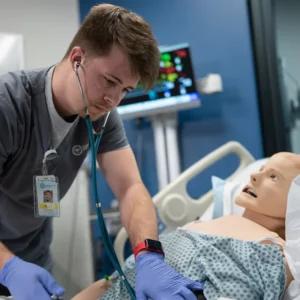The Physical Therapist Assistant (PTA) program[1] at Carrington College gives students the hands-on training they need to help patients feel better. To show you what you’ll learn on the PTA program, we spent a day with students and faculty to find out more.
What would I do as a Physical Therapist Assistant?
As a physical therapist assistant you could be helping one patient recover from an injury, then showing your next patient different ways to improve their everyday quality of life. You’ll play an important part in their recovery as they try to regain mobility and independence.
What do Carrington students learn in the program?
The human body is complicated, so there’s a lot to learn in less than two years[2] on the Physical Therapist Assistant Associate Degree program. So what does student Martha say she’s learned so far? “Everything! There’s so much! We’ve learned all our hands-on skills, a bunch of different manual therapy techniques, how to transfer patients – that means how to physically pick them up and move them to different places,” she said. PTA students Alexander and Shelby shared what they’ve learned in Anatomy class. “Basically the anatomy of the bones, the muscles, tissues; how they function with each other,” said Alexander. “Right now we’re learning about the Central Nervous System and the Peripheral Nervous System,” added Shelby. Two years isn’t that long when there’s so much to learn. Shelby says that she keeps it all straight by prioritizing study time. “I go over what I learned in class on my car ride in and my car ride home,” she explained.
How will the class work help prepare me for the work I’ll do in the lab?
So many people learn better by working with their hands, rather than just reading the information in a book. Does that sound like you? “We work on models, bones, muscles…everything that we learn in class helps us prepare for the labs,” said PTA student Ron. Jim, Director of Clinical Education for the Physical Therapist Assistant program explains why PTA class work is important, and how it relates to the lab work. “The classroom really helps to give students the fundamental knowledge; they learn techniques and terminology. Then in the lab they learn how to apply those techniques, so there’s a lot more hands-on interventions,” said Jim. Just so you know, “interventions” in the field of physical therapy are defined as “the interactions and procedures used in managing and instructing patients/clients.[3]” Basically that means the way physical therapists and physical therapist assistants solve a patient’s problem is through “interventions”.
What are the clinical rotations like?
Jim explains why clinical rotations – the real-world experience built into the program – are his favorite part for students. “They’re getting patients well, they’re getting patients up out of bed, and they’re doing interventions to help alleviate pain. We get to take a student and transform them into a clinician,” said Jim. PTA student Ron believes it’s very useful to have real-world experience as part of the program. “In my previous job it was bookwork and stuff like that, so learning and being able to apply what I’ve learned in the classroom to people is very helpful,” he said.
Why would I choose the Physical Therapist Assistant program?
People get into the physical therapy field for a number of personal reasons; perhaps to help a family member or a friend, or maybe they saw the positive difference physical therapy can make to quality of life first hand. That was the case for PTA student Alexander. “I actually hurt myself in high school playing football, I tore my ACL. Just interacting with the physical therapists really got me interested. I liked how I went from not being able to walk on my first day of physical therapy, to being able to do everything just as I could before my injury. I really want to help people…just as I was helped,” he explained.
So what are you waiting for?
We’ll give the last word to PTA student Alexander who has some advice for anyone thinking of a career in physical therapy; “if you’re interested in this type of field, just go for it. Set up an appointment, take a tour of the campus. That’s what I did and it was awesome; it was the best decision I ever made.” To learn more about the Physical Therapist Assistant program at Carrington College, click here.
[1] Important information about the educational debt, earnings and completion rate of students who attended this program can be found at carrington.edu/cc/pta. [2] Not including breaks. Program length by weeks and admission requirements can be found here in the academic catalog. [3] http://www.apta.org/PTCareers/RoleofaPT/



